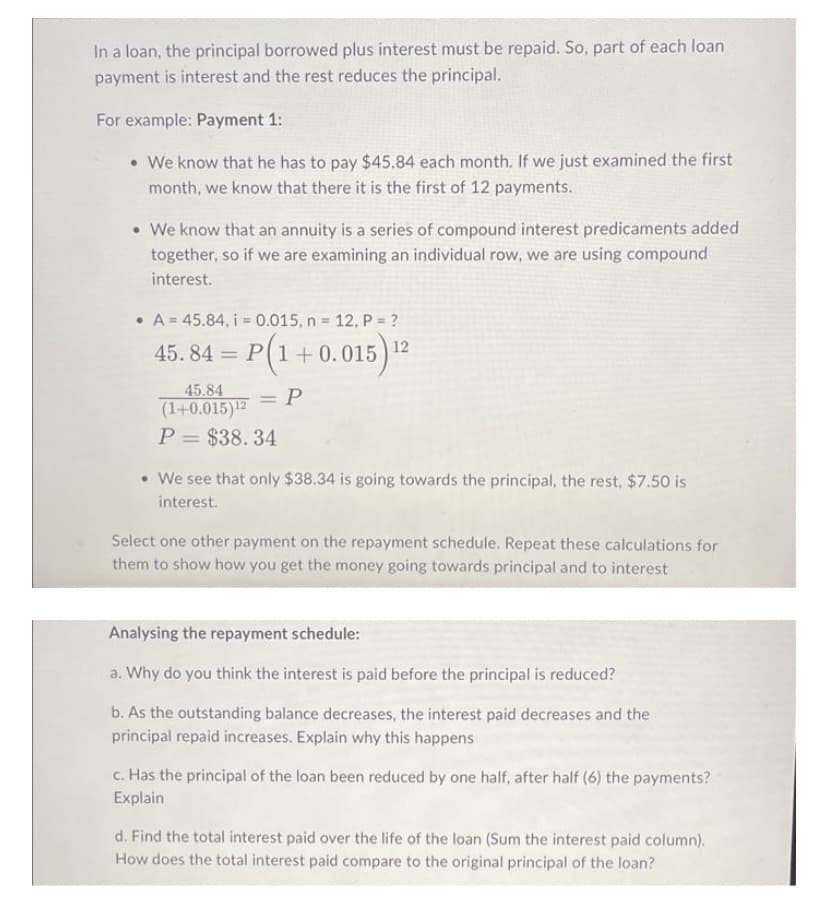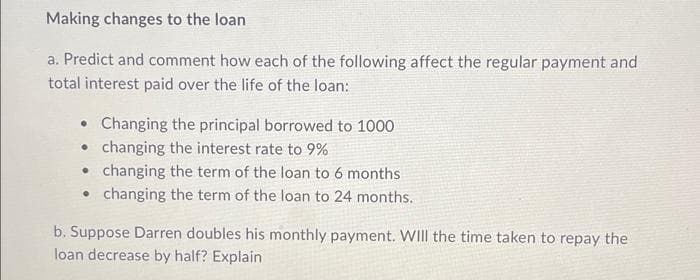In a loan, the principal borrowed plus interest must be repaid. So, part of each loan payment is interest and the rest reduces the principal. For example: Payment 1: • We know that he has to pay $45.84 each month. If we just examined the first month, we know that there it is the first of 12 payments. • We know that an annuity is a series of compound interest predicaments added together, so if we are examining an individual row, we are using compound interest. • A = 45.84, i = 0.015, n = 12, P = ? 45. 84 = P(1+0.015)' 12 45.84 = P (1+0.015)12 P = $38.34 %3D %3D • We see that only $38.34 is going towards the principal, the rest, $7.50 is interest. Select one other payment on the repayment schedule. Repeat these calculations for them to show how you get the money going towards principal and to interest Analysing the repayment schedule: a. Why do you think the interest is paid before the principal is reduced? b. As the outstanding balance decreases, the interest paid decreases and the principal repaid increases. Explain why this happens c. Has the principal of the loan been reduced by one half, after half (6) the payments? Explain d. Find the total interest paid over the life of the loan (Sum the interest paid column). How does the total interest paid compare to the original principal of the loan?
In a loan, the principal borrowed plus interest must be repaid. So, part of each loan payment is interest and the rest reduces the principal. For example: Payment 1: • We know that he has to pay $45.84 each month. If we just examined the first month, we know that there it is the first of 12 payments. • We know that an annuity is a series of compound interest predicaments added together, so if we are examining an individual row, we are using compound interest. • A = 45.84, i = 0.015, n = 12, P = ? 45. 84 = P(1+0.015)' 12 45.84 = P (1+0.015)12 P = $38.34 %3D %3D • We see that only $38.34 is going towards the principal, the rest, $7.50 is interest. Select one other payment on the repayment schedule. Repeat these calculations for them to show how you get the money going towards principal and to interest Analysing the repayment schedule: a. Why do you think the interest is paid before the principal is reduced? b. As the outstanding balance decreases, the interest paid decreases and the principal repaid increases. Explain why this happens c. Has the principal of the loan been reduced by one half, after half (6) the payments? Explain d. Find the total interest paid over the life of the loan (Sum the interest paid column). How does the total interest paid compare to the original principal of the loan?
Chapter16: Working Capital Policy And Short-term Financing
Section: Chapter Questions
Problem 14P
Related questions
Concept explainers
Mortgages
A mortgage is a formal agreement in which a bank or other financial institution lends cash at interest in return for assuming the title to the debtor's property, on the condition that the obligation is paid in full.
Mortgage
The term "mortgage" is a type of loan that a borrower takes to maintain his house or any form of assets and he agrees to return the amount in a particular period of time to the lender usually in a series of regular equally monthly, quarterly, or half-yearly payments.
Question

Transcribed Image Text:In a loan, the principal borrowed plus interest must be repaid. So, part of each loan
payment is interest and the rest reduces the principal.
For example: Payment 1:
• We know that he has to pay $45.84 each month. If we just examined the first
month, we know that there it is the first of 12 payments.
• We know that an annuity is a series of compound interest predicaments added
together, so if we are examining an individual row, we are using compound
interest.
• A = 45.84, i = 0.015, n 12, P = ?
%3D
!!
45. 84 = P(1+0.015) 2
%3D
45.84
(1+0.015)12
P = $38.34
= P
%3D
• We see that only $38.34 is going towards the principal, the rest, $7.50 is
interest.
Select one other payment on the repayment schedule, Repeat these calculations for
them to show how you get the money going towards principal and to interest
Analysing the repayment schedule:
a. Why do you think the interest is paid before the principal is reduced?
b. As the outstanding balance decreases, the interest paid decreases and the
principal repaid increases. Explain why this happens
c. Has the principal of the loan been reduced by one half, after half (6) the payments?
Explain
d. Find the total interest paid over the life of the loan (Sum the interest paid column).
How does the total interest paid compare to the original principal of the loan?

Transcribed Image Text:Making changes to the loan
a. Predict and comment how each of the following affect the regular payment and
total interest paid over the life of the loan:
Changing the principal borrowed to 1000
changing the interest rate to 9%
changing the term of the loan to 6 months
• changing the term of the loan to 24 months.
b. Suppose Darren doubles his monthly payment. WIll the time taken to repay the
loan decrease by half? Explain
Expert Solution
This question has been solved!
Explore an expertly crafted, step-by-step solution for a thorough understanding of key concepts.
Step by step
Solved in 3 steps with 2 images

Knowledge Booster
Learn more about
Need a deep-dive on the concept behind this application? Look no further. Learn more about this topic, finance and related others by exploring similar questions and additional content below.Recommended textbooks for you

EBK CONTEMPORARY FINANCIAL MANAGEMENT
Finance
ISBN:
9781337514835
Author:
MOYER
Publisher:
CENGAGE LEARNING - CONSIGNMENT


EBK CONTEMPORARY FINANCIAL MANAGEMENT
Finance
ISBN:
9781337514835
Author:
MOYER
Publisher:
CENGAGE LEARNING - CONSIGNMENT
